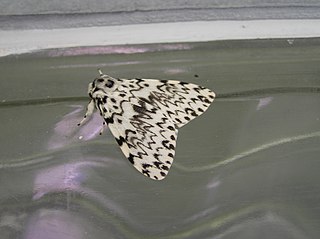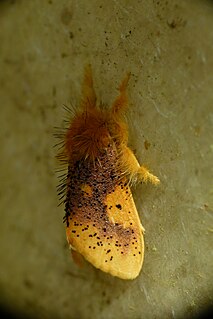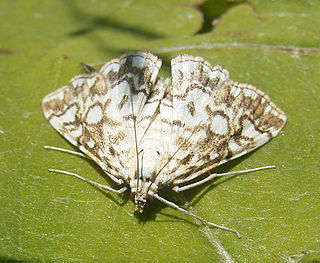
Utetheisa is a genus of tiger moths in the family Erebidae. The genus was first described by Jacob Hübner in 1819.
Eugoa is a genus in the family Erebidae, subfamily Arctiinae. The genus was erected by Francis Walker in 1858. They are found in India, Sri Lanka, Myanmar and Borneo.

Lymantria is a genus of tussock moths in the family Erebidae. They are widely distributed throughout Europe, Japan, India, Sri Lanka, Myanmar, Java, and Celebes. The genus was described by Jacob Hübner in 1819.
Abynotha is a genus of erebid moths in the subfamily Lymantriinae. The genus was first described in 1903 by Charles Swinhoe.

Ivela is a genus of moths in the subfamily Lymantriinae. The genus was erected by Charles Swinhoe in 1903.
Marbla is a genus of moths in the subfamily Lymantriinae. The genus was erected by Charles Swinhoe in 1903.

Nygmia is a genus of tussock moths in the family Erebidae. The genus was erected by Jacob Hübner in 1820.
Stracena is a genus of moths in the subfamily Lymantriinae. The genus was erected by Charles Swinhoe in 1903.

Asota is a genus of moths in the family Erebidae first described by Jacob Hübner in 1819. Species are widely distributed throughout Africa, India, Sri Lanka, Myanmar, the Malayan region and tropical parts of the Australian region.

Chrysocraspeda is a genus of moths in the family Geometridae described by Charles Swinhoe in 1893.
Oreta is a genus of moths belonging to the subfamily Drepaninae. The genus was erected by Francis Walker in 1855.

Lepidoptera Indica was a 10 volume work on the butterflies of the Indian region that was begun in 1890 and completed in 1913. It was published by Lovell Reeve and Co. of London. It has been considered the magnum opus of its author, Frederic Moore, assistant curator at the museum of the East India Company. Frederic Moore described a number of new species through this publication. Moore was a splitter, often creating new genera for species and new species for what are now treated as subspecies.

Lymantria xylina, the casuarina moth or casuarina tussock moth, is a moth in the family Erebidae. The species was first described by Charles Swinhoe in 1903. It is found in Japan, Taiwan and the Chinese provinces of Fujian and Guangdong.

Acentropinae is a fairly small subfamily of the lepidopteran family Crambidae, the crambid snout moths. Species of this subfamily are exclusively found in wetlands and aquatic habitats.
Holocraspedon erkunin is a moth of the family Erebidae first described by Arnold Pagenstecher in 1885. It is found on Aru and New Guinea.
Eugoa vasta is a moth of the family Erebidae. It is found on Java.
Phalacra acutipennis is a moth in the family Drepanidae. It was described by Swinhoe in 1903. It is found in the Khasi Hills of India.
Prasinoxena viridissima is a species of moth in the family Pyralidae first described by Charles Swinhoe in 1903. It was found in Selangor, Malaysia.








